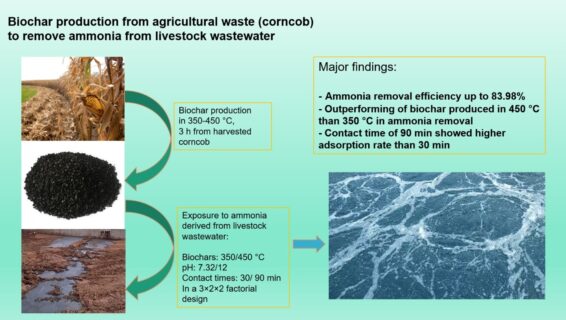Biochar production from agricultural waste (corncob) to remove ammonia from livestock wastewater
Authors
Abstract
Purpose: With the constant increase in food demand, agriculture became the second-highest waste-generating industry. Crop residues and wastewater from livestock farming are the major contributors and irrational disposal of them has a serious impact on ecosystems as well as human health. In this study, corncob as agriculture waste was used as a treatment agent, after converting it to biochar that adsorbs ammonia nitrogen in swine wastewater.
Method: The biochar was prepared by pyrolysis at two different temperatures 350 °C and 450 °C. The physical properties of the biochar were investigated using scanning electron microscopy (SEM) analysis. The ammonia adsorption capacities and removal efficiencies of the two biochars were investigated using batch experiments by changing the pH of the wastewater solution as well as the contact time.
Results: The highest ammonia removal efficiency of 83.98% was recorded at 450 °C after 90 min of contact time under alkaline pH (12) wastewater conditions whereas the lowest removal efficiency of 34.64% was obtained for 350 °C after 30 min exposure to wastewater at normal pH (7.32) condition.
Conclusion: This study contributed to the ongoing research on the potential of feedstock-derived biochar to remove pollutants from wastewater.
Highlights:
- A higher temperature (450 °C) in the processing of corncob biochar had more potential to adsorb ammonia from livestock wastewater than a lower temperature (350 °C).
- Increased pH (12) caused increased ammonia from 3.06 to 6.2 mg/l from normal pH (7.32) of wastewater samples; it was not saturated by corncob and showed higher adsorption rate by biochar.
- This study encourages the usage of agricultural waste (corncob) in beneficiary effects of wastewater treatment with the lowest expenses and being highly environmentally friendly.





